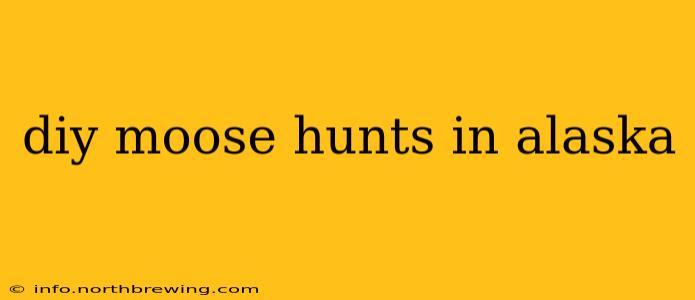Alaska. The very name conjures images of vast wilderness, towering mountains, and majestic moose. For many hunters, a DIY moose hunt in Alaska represents the ultimate challenge and reward. This comprehensive guide will delve into the planning, preparation, and execution of a successful do-it-yourself moose hunt in the Last Frontier. We'll cover everything from obtaining licenses and permits to navigating the Alaskan backcountry and ensuring a safe and ethical hunt.
What are the Requirements for a DIY Moose Hunt in Alaska?
This is a crucial first step. Successfully navigating the regulatory landscape is paramount for a legal and enjoyable hunt. You'll need to understand the specific regulations for the area you choose to hunt. This includes:
-
Obtaining the necessary hunting licenses and permits: Alaska's Department of Fish and Game (ADF&G) website is your primary resource. You’ll need to apply well in advance, as licenses are often allocated through a drawing system. Be sure to understand the different license types (resident vs. non-resident) and the associated fees.
-
Understanding hunting seasons and regulations: Seasons vary by region and game management unit (GMU). Familiarize yourself with legal hunting methods, bag limits, and prohibited areas. Ignoring these regulations can lead to hefty fines and even the loss of hunting privileges.
-
Knowing the required hunting equipment and safety gear: This will depend heavily on your chosen hunting method (e.g., spot-and-stalk, calling). Essential items include appropriate firearms (caliber restrictions may apply), ammunition, optics (binoculars and a spotting scope are highly recommended), first-aid kit, navigation tools (GPS, map, compass), and appropriate clothing for all types of weather conditions. Remember, Alaska's weather can change rapidly.
What is the Best Time of Year for a DIY Moose Hunt in Alaska?
The optimal time for a DIY moose hunt in Alaska generally aligns with the rutting season (typically September and October). This is when moose are most active and easier to locate. However, the specific timeframe depends on the GMU and can vary from year to year. Consulting the ADF&G website for updated season dates is essential. Early season hunts can also be successful but require more scouting and preparation.
How Much Does a DIY Moose Hunt in Alaska Cost?
The cost of a DIY moose hunt can vary significantly, depending on several factors:
- Travel expenses: Flights, rental cars, and potential fuel costs for your own vehicle will significantly impact the budget.
- Accommodation: Choosing between backcountry camping, lodging in a remote cabin, or staying in a more established town will influence expenses.
- Hunting licenses and permits: Non-resident license fees are considerably higher than resident fees.
- Gear and equipment: The cost of firearms, optics, and other essential gear can be substantial, but investing in quality equipment is crucial for a safe and successful hunt.
- Food and supplies: Plan for plenty of provisions, as access to stores may be limited in remote areas.
What is the Best Way to Find Moose in Alaska?
Successfully locating moose requires a combination of strategy, skill, and a little bit of luck. Common methods include:
- Scouting: Pre-hunt scouting, either physically or via aerial imagery, is invaluable. Look for signs of moose activity, such as tracks, scat, and feeding areas.
- Spotting: Patience and keen observation are key. Scanning the landscape with binoculars and a spotting scope is crucial for spotting moose in their natural habitat.
- Calling: While not always effective, moose calling can sometimes attract curious bulls within range.
What are the Safety Precautions for a DIY Moose Hunt in Alaska?
Safety should be your top priority. Alaska's wilderness presents unique challenges, and preparedness is essential:
- Inform someone of your hunting plans: Always let someone know your itinerary, including your planned hunting area, expected return time, and emergency contact information.
- Carry a communication device: A satellite phone or personal locator beacon (PLB) can be lifesavers in emergency situations.
- Be aware of wildlife: Alaska is home to various dangerous animals, including bears and wolves. Carry bear spray and know how to use it.
- Pack extra food and water: Unexpected delays can happen, so be prepared for extended stays in the wilderness.
What is the Best Hunting Weapon for Moose in Alaska?
While various firearms are legal, high-caliber rifles are generally preferred for moose hunting due to the animal's size and the need for a clean, ethical kill. Always check the specific regulations for your chosen GMU regarding legal calibers and ammunition types.
What Should I Do if I Harvest a Moose?
Successfully harvesting a moose involves several crucial steps:
- Ensure a clean and ethical kill: Aim for vital areas to ensure a quick and humane harvest.
- Properly field dress the moose: This involves removing the animal's internal organs to prevent spoilage.
- Transport the meat: Properly transporting the meat to your chosen location is essential to preserve its quality. You’ll need to consider how you will get it out of the backcountry.
Planning a DIY moose hunt in Alaska requires meticulous preparation and careful consideration of the potential risks and rewards. Thorough research, respect for the regulations, and a commitment to safety will greatly increase your chances of a successful and memorable hunt. Remember, the Alaskan wilderness is unforgiving, so thorough preparation and awareness are key to a safe and enjoyable experience.
